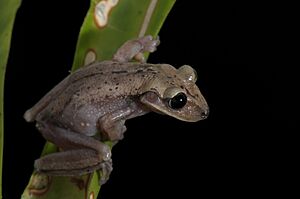Nyctimantis facts for kids
Quick facts for kids Nyctimantis |
|
|---|---|
 |
|
| Nyctimantis bokermanni | |
| Scientific classification |
|
| Kingdom: | Animalia |
| Phylum: | Chordata |
| Class: | Amphibia |
| Order: | Anura |
| Family: | Hylidae |
| Subfamily: | Lophyohylinae |
| Genus: | Nyctimantis Boulenger, 1882 |
| Species | |
|
see text |
|
| Synonyms | |
|
|
Nyctimantis is a fascinating group of frogs that belong to the family Hylidae, also known as tree frogs. These unique frogs are mostly found in the warm, wet regions of South America. They live in places like south-eastern Brazil and the Orinoco River Basin in Venezuela, Colombia, and parts of Brazil.
These frogs are known for their special way of life. They are mostly tree-dwelling, which means they spend most of their time living in trees. They often hide in the "cisterns" of epiphytic bromeliads. Bromeliads are plants that grow on other plants, and their leaves form natural cups that collect water, creating tiny pools perfect for these frogs. One of the most amazing features of Nyctimantis frogs is the bony plate on top of their head. This plate is actually fused with their skin, making their head look like it's wearing a helmet!
Contents
Meet the Casque-Headed Frogs!
Nyctimantis frogs are often called "casque-headed" frogs because of the special bony plate on their heads. A "casque" is like a helmet. This unique feature helps them in their environment. Scientists believe this hard head might help them plug up the entrance to their hiding spots in bromeliads, protecting them from predators or keeping them moist.
What Makes Them Special?
Besides their helmet-like heads, these frogs have other cool adaptations. They are usually small to medium-sized frogs. Their skin often has patterns or colors that help them blend in with their surroundings, like tree bark or leaves. This camouflage is very important for hiding from animals that might want to eat them.
Their home in bromeliads is also very special. These plants provide them with water to stay hydrated and a safe place to live and lay their eggs. The frogs can spend their entire lives within a single bromeliad plant, finding food and shelter there.
Where Do They Live?
You can find Nyctimantis frogs in different parts of South America. They prefer tropical and subtropical forests where there is plenty of rainfall and humidity. Their main homes are in the dense forests of south-eastern Brazil. You can also find them further north, in the large area drained by the Orinoco River, which flows through Venezuela, Colombia, and Brazil. These areas are rich in biodiversity, meaning they have many different kinds of plants and animals.
Different Kinds of Nyctimantis Frogs
In 2021, scientists looked closely at the family tree of these frogs. They used something called "phylogenetic evidence," which is like using DNA and other clues to figure out how different species are related. Based on this evidence, they decided to group many frogs that were previously in other groups, like Aparasphenodon and Argenteohyla, into the Nyctimantis genus. This means those older names are now considered "synonyms," or different names for the same group of frogs.
Here are some of the species recognized in the Nyctimantis genus:
| Binomial Name and Author | Common Name |
|---|---|
| Nyctimantis arapapa Pimenta, Napoli & Haddad, 2009 | Bahia's broad-snout casque-headed tree frog |
| Nyctimantis bokermanni Pombal, 1993 | Bokermann's casque-headed frog |
| Nyctimantis brunoi Miranda-Ribeiro, 1920 | Bruno's casque-headed frog |
| Nyctimantis galeata (Pombal, Menezes, Fontes, Nunes, Rocha, and Van Sluys, 2012) | Casque-headed tree frog |
| Nyctimantis pomba Assis, Santana, Silva, Quintela, and Feio, 2013 | Pomba casque-headed frog |
| Nyctimantis rugiceps Boulenger, 1882 | Brown-eyed treefrog |
| Nyctimantis siemersi (Mertens, 1937) | Red-spotted Argentina frog |

